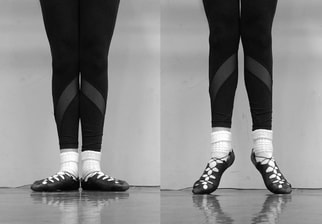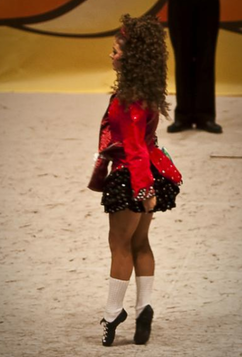 So far in technique review we’ve covered turnout, crossing, and posture—but we’re not done yet! We’re moving away from the arms and shoulders this week and returning to the feet as we discuss one of most important aesthetic and technical components of Irish dance: height on toes. As almost all movements are performed on the balls of the feet, maintaining height on your toes is necessary to properly execute all dances! While the term “height on toes” may conjure up the image of a ballet dancer in pointe shoes, what we’re referring to here is the ability of an Irish dancer raising themselves fully on the balls of their feet, not the tips of their toes. Though there is an exception to this rule (the “heel” or “stamp”) where the foot makes full contact with the floor, outside of this an Irish dancer must never let their arch or heel touch the floor! And yes, that even includes landing jumps! This can be particularly challenging for dancers while performing in hard shoe. Though the fiberglass heels of today’s hard shoes are much lighter than their predecessors, they can still often feel very heavy, especially to beginners, leading to dropped heels while dancing. This is an even more glaring issue when in hard shoe (as opposed to soft ghillies) as it’s not just improper technique, but leads to unnecessary additional sounds that can disturb your rhythm! As dancers move up through the levels, they’re not only expected to stay on their toes, but that their height on toes is so extended that they’re dancing well up on the balls of their feet, close to the base of their toe. Thus, performing strengthening exercises for your calves and feet outside of class is one of the keys to improving as an Irish dancer across the board. While there’s numerous theraband exercises that can help with conditioning your calves and feet, and single leg calf raises are a good workout as well, Miss Courtney recommends “doming” as the best possible way to help increase your arch strength and shaping.  Doming is an exercise (see it in action here!) that not only works the larger muscles of your foot, but aims to involve the smaller, intrinsic muscles that are buried deep within the bottom of your foot. Strengthening these smaller muscles helps stabilize the joints of the foot as a whole, providing a more stable base for dancers to jump, jig, and move. You know how core strength is what keeps us upright? Think of this as core strength for your foot! (Check out some more tips from Irish Dancing & Culture magazine here and from Target Training Dance—a great resource--here.) It’s incredibly important for Irish dancers to make sure their feet and calves are at full strength, and not just because a lowered heel could knock you down a place during judging. A study in The Journal of Athletic Training in 2017 reports that fatigue in Irish dancers leads to heel drops and thus an increased risk of lower limb injury. Increasing the stamina of your height on your toes is imperative to help avoid the arch and heel release that can lead to injuries such as stress fractures, ankle sprains, and plantar fasciitis, among others. But, like anything else in life, preparation is the best way to avoid any problems, so get your dancer working on calf and foot strength sooner rather than later! This post is part of a series. Check out our last technique post, all about posture, here. Check out the blog every Monday and Thursday for more posts about Irish history, dance culture, community news, and spotlights on our dancers, staff, and families—among other fun projects! And don’t forget to dance along with us on both Facebook and Instagram.
0 Comments
Your comment will be posted after it is approved.
Leave a Reply. |
SRL NewsFind all of our latest news on our Scoil Rince Luimni Facebook page! Categories
All
Archives
August 2022
|

 RSS Feed
RSS Feed